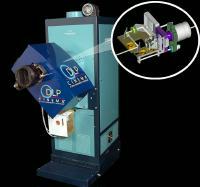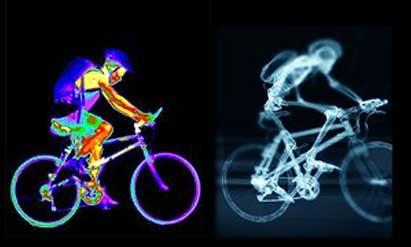New 3D cinema
2008/09/01 Roa Zubia, Guillermo - Elhuyar Zientzia Iturria: Elhuyar aldizkaria
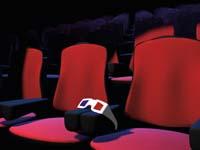
However, the market is not exhausted, at least large companies do not consider it exhausted. Three-dimensional films are (or have existed) exhibited in different theme parks and some expo exhibitions. This is what to do to expand the market. The problem is both technological and economic. Good three-dimensional imaging systems have been developed, but they are very expensive.
Two eyes, two pictures
The base is simple and economical. The key is to give a single image to each eye, and make them very similar. It is what the eyes do to see the three-dimensional reality: each eye receives a very similar but different image.
Between both eyes there are about six centimeters, so any object in front of the nose we see from two angles. The right eye sees the front and right of things and the left, front and left eyes. The closer the object is to be seen, the greater the difference between the two images. The brain is the one that creates the optical illusion of the three dimensions (and the sensation of distance) when mixing the images. In short, it is a type of triangulation.
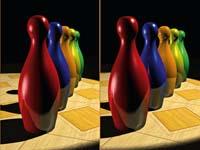
The effect is evident with the very image of the nose; each eye sees it from very different points of view. However, it is impossible to look at the nose simultaneously with two eyes to create a three-dimensional representation. It is too close for it. But if the images have a minimal resemblance and each eye is given an image taken from the corresponding angle, the brain does the job.
And that is the effect used in three-dimensional films. Create two images per frame. The effect of the three dimensions is normally obtained with an angle between the two views of 5-6 degrees. An image to each eye and brain produces the effect. This process is called stereoscopy.
Glasses
Technical difficulties begin when each image is sent to a specific eye. In the films, the two images are linked on the screen, but they have a distinctive feature, that is, a feature that serves to differentiate them. The separation is done by glasses in front of each eye.

The effect is achieved, but it is not a good technique because it distorts the colors. The image is poorly focused and the distortion must be compensated by the filter itself. For example, with glasses with cellophane filter, the distortion is very large, the best result is achieved with acrylic lenses, although it must compensate for a half diopter in the red part.
The other option is to polarize both images and the glasses filters have polarized light filters. If one image is made up of vertical lines and the other is made up of horizontal lines, they are easily distinguished by grille, vertical and horizontal filters. For polarized light is so, but applied to the light wave. The problem arises when the spectator tilts his head, so in some cases circular polarization is used, that is, that which rotates in the same or in the opposite direction of the clock hands when the polarized wave advances. This system gives much better result than anaglife. It does require polarization of images.
IMAX
At the Osaka Expo in 1990, a new system with no polarized image applied to IMAX technology was presented: IMAX SOLID. Play with time. The cinema shows 24 frames per second; IMAX, instead of presenting the two stereoscopy images simultaneously, alternates them, one for the left eye and one for the right. In total there are 48 frames in a second. Next to this, one eye must be covered in the middle of the frame and the other in the other half, and there is the work of the glasses: the glasses have a shutter in the windows and are synchronized with the display of the film.

The main advantage of IMAX is that it uses a single projector, since it does not project the two stereoscopy images simultaneously. This greatly simplifies the technology of the projector, but makes the glasses much more complex. In the end it is a very expensive product, because all the viewers who are in the cinema have to have those technological glasses.
The system is not commercially viable, at least on a large scale. In addition to the Osaka Expo, in Seville in 1992, the only one in Europe is in the Futuroscope theme park. In short, the results are good, but the system is very expensive.
Real D
IMAX SOLID is not the latest technology in three-dimensional films. The Disney company has developed a new system called Real D, which supposedly aims to reopen three-dimensional films to commercial cinema. In 2005 he presented his first film with this system: 3D of Little Chicken, three-dimensional version of Chicken Little. Since then he has made (and is doing) both versions of existing and new films for the three-dimensional system.
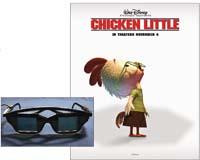
On the one hand, as in IMAX, the images of both eyes are not projected simultaneously, but by turns. That's why they need a single projector, although it's a very fast projector. To make the image more stable, they project three times the same frame for better quality: each eye, instead of receiving 24 frames per second, receives 72 frames. The projector must therefore operate at 144 frames per second.
On the other hand, they use circular polarized light. Therefore, Real D glasses should not cover one or another eye on each frame. It is not necessary to synchronize the glasses with the projector. Instead of playing with glasses, the projector itself polarizes the frames using a pair of filters. These filters are alternated by the projector 144 times in a second. This system requires a fast and complex projector, but when using cheap glasses, the system is more suitable and cheaper for use in commercial rooms.
However, it is a bet. To use the Real D, the owners of the commercial rooms must purchase a complex projector. It seems that this system will never be as successful as conventional cinema, but it can also have a market. The same goes for planetariums, who need a special and expensive projector, and who have less planetarium than conventional cinemas, but the Real D is more extensible than the SOLID IMAX.
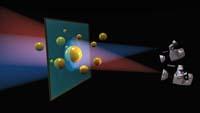
According to Disney, with Chicken Little 3D in three dimensions they earned more money than with Bidimensional. It is necessary to analyze, however, whether this data is representative of the film industry.
But it is clear that, at least right now, the market is expanding both in the United States and in Europe (Kinepolis, for example, opened in 2007 17 rooms to see Real D, 10 in Belgium, 6 in France and one in Spain). With this system seven films have been released and production of another nine is underway. Three-dimensional films have been translated.
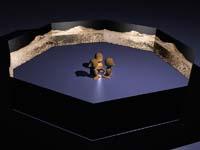

Gai honi buruzko eduki gehiago
Elhuyarrek garatutako teknologia



